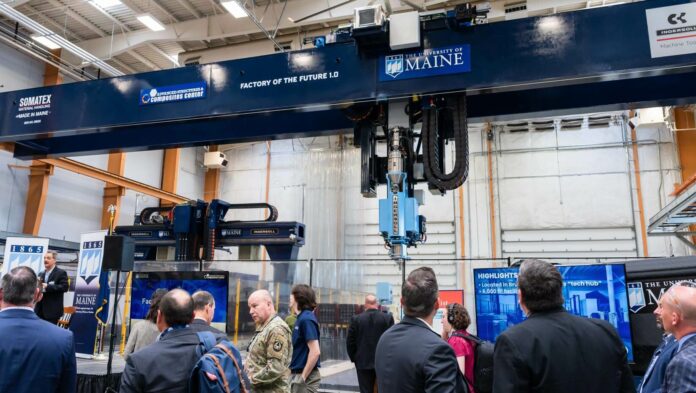The University of Maine has developed a 3D printer that is four times larger than its predecessor. The polymer 3D printer called Factory of the Future 1.0 (FoF 1.0) would surpass the 2019 Guinness World Record the university previously earned for a polymer 3D printer.
The thermoplastic polymer printer is designed to print objects as large as 96 feet long by 32 feet wide by 18 feet high and can print up to 500 pounds per hour. (This translates into 29 cm X 10 cm x 5 cm for a printing process that goes up to 227 kg per hour)
FoF 1.0 switches between various processes such as large-scale additive manufacturing, subtractive manufacturing, continuous tape layup, and robotic arm operations.
The Advanced Structures and Composites Center (ASCC) which hosts the new and former 3D printers (MasterPrint), will streamline manufacturing innovation research as both machines could share the same end-effectors or work on the same part.

“FoF 1.0 opens up new research frontiers to integrate these collaborative robotics operations at a very large scale with new sensors, high-performance computing and artificial intelligence to create born-certified systems that meet high quality standards,” said ASCC Executive Director Habib Dagher. “We are grateful for Senator Collins’ support, for support from Maine’s congressional delegation and for collaborations with the Department of Defense, Department of Energy, Oak Ridge National Labs, Maine Housing and our industry partners here in Maine and beyond.”
The design and fabrication of this hybrid manufacturing system was made possible with support from the Office of the Secretary of Defense through the U.S. Army Corps of Engineers.
Through the applications it can enable, FoF 1.0 can benefit numerous industries, including national security, affordable housing, bridge construction, ocean and wind energy sectors as well as maritime vessel fabrication. Given the fact that, Senator Collins, vice chair of the Senate Appropriations Committee and Subcommittee on Defense, has secured more than $93 million (since fiscal year 2022) in support of this initiative and other defense projects at the ASCC, we anticipate that the defense would be one of the main sectors benefitting from this new solution.
The first initiatives that will be advanced include the development of biobased feedstocks from wood residuals abundant in Maine, commercialization efforts such as BioHome3D as well as technological advancements for national security, particularly in lightweight rapidly deployable structures and vessel technologies.
Remember, you can post job opportunities in the AM Industry on 3D ADEPT Media free of charge or look for a job via our job board. Make sure to follow us on our social networks and subscribe to our weekly newsletter : Facebook, Twitter, LinkedIn & Instagram ! If you want to be featured in the next issue of our digital magazine or if you hear a story that needs to be heard, make sure to send it to contact@3dadept.com.






